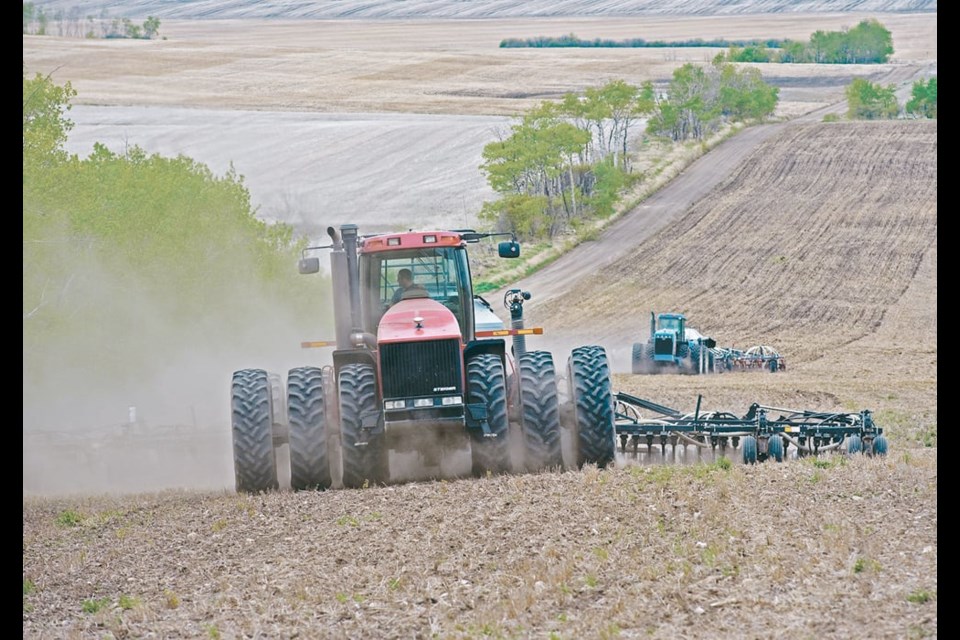WESTERN PRODUCER – For years, agronomists and canola experts have told growers to seed canola earlier in the spring to optimize yield potential.
But now with flea beetles often causing massive damage, farmers and insect specialists are reconsidering that advice.
A percentage of farmers continue to seed canola as early as possible. Others are deliberately seeding canola in late May.
“The thinking is kind of split, right now,” said Chuck Fossay, who farms near Starbuck, Man., and is the president of the Manitoba Canola Growers Association.
“In my area, there are some guys seeding their soybeans before they seed their canola. And they’re getting some pretty good results.”
Fossay answered a few questions about flea beetles and seeding dates at Manitoba Ag Days in Brandon, an annual trade show where the MCGA held a meeting Jan. 18.
Flea beetles are rarely a problem across the entire Prairies for the 20 to 22 million acres of canola that are planted in spring.
However, there are geographic pockets every year, possibly representing millions of acres, where the pests become a massive issue. The beetles feed on canola seedlings and can quickly consume the leaves or stems of young canola plants.
Growers in affected regions are forced to spray foliar insecticides three or four times to prevent the beetles from destroying the crop.
And every year, some farmers have to reseed their canola because of beetle damage.
Tyler Wist, a field crop entomologist with Agriculture Canada, also spoke about flea beetles at Ag Days. The topic of his presentation was research on insecticide seed treatments and how they protect canola against flea beetles early in the growing season.
Research from 15 years ago showed that early planting of canola was a better option. That way, canola plants would pop out of the ground and get established before flea beetles appeared in huge numbers.
However, those results applied to crucifer flea beetles, not striped flea beetles.
In the last decade, or so, striped flea beetles have become much more common across the Prairies. They usually emerge two weeks before crucifers.
“Early on, it was all crucifer flea beetles when that work (research) was done.
“So, all of that (previous) stuff is sort of out the window. I wouldn’t say that anymore. I might even say, seed a little bit later,” Wist said.
“Why is that? Your ground is warmer, your plant comes up quicker. It takes up the insecticide better from the seed treatment. And it’s not sitting around … in a vulnerable stage (cotyledon stage).”
Last July, the MCGA surveyed its members to understand the relationship between flea beetles and seeding dates.
Seeding was delayed in 2022 because of excess moisture and cold temperatures, but growers who seeded early or late seemed to have more success.
“The producers that seeded their canola before May 20 had very few issues,” Fossay said. “Farmers that seeded after June 4 had very few issues with flea beetles.”
If they planted canola between May 20 and June 4, many had major problems.
However, Fossay added the calendar shouldn’t dictate when to seed canola. Farmers should pay close attention to soil temperatures.
“I think the first thing to look at is soil temperature. If the soil is warm, it doesn’t matter whether you’re seeding early in May or late in May,” he said.
“In the last couple of years, the guys in my area who seeded the 10th or 15th of May, the soil was cold … and it took 10 days or more for the seed to emerge.”
Temperature may be important, but few growers are taking soil temperature readings before they plant canola.
“(It’s) not really very common. Most guys are ‘the field is dry, I can travel on it. Let’s go’, ” Fossay said.
Warren Ward, a Canola Council of Canada agronomist in eastern Saskatchewan, said some growers in his region are thinking about seeding dates and how to avoid beetles. However, there are other risks to consider.
“Solving one problem could put you in front of another problem,” Ward said.
Seeding in late May can push the bloom period for canola into mid- or late July, possibly increasing the risk of 32 C temperatures at flowering.
A blast of heat, days above 28 C and nighttime temperatures warmer than 16 C, means fewer flowers on a canola plant and lower yields.
“With flea beetles … we do have management options for it, whereas with something like heat blast, there isn’t a lot you can do about it,” Ward said.
“That’s always been the reason that people do try and seed canola a little bit earlier.”
Yield data from the Manitoba Agricultural Services Corp., the provincial crop insurer, shows that early seeding results in higher canola yields, on average.
However, if growers choose to plant at a later date, yield potential is still high.
“The yields for canola hold up … relatively later into the (planting) season,” said Darren Bond, a farm management specialist with Manitoba Agriculture.
“Canola is the one (crop) you can push back a little bit.”




